

Free data, statistics, analysis, visualization & sharing - knoema.com. Cheat Sheets for AI, Neural Networks, Machine Learning, Deep Learning & Big Data. Essential Cheat Sheets for Machine Learning and Deep Learning Engineers. Kailashahirwar/cheatsheets-ai: Essential Cheat Sheets for deep learning and machine learning researchers. Machine Learning For Dummies Cheat Sheet - dummies. From Machine Learning For Dummies By John Paul Mueller, Luca Massaron Machine learning is an incredible technology that you use more often than you think today and with the potential to do even more tomorrow.
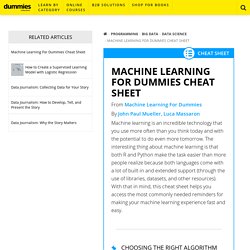
The interesting thing about machine learning is that both R and Python make the task easier than more people realize because both languages come with a lot of built-in and extended support (through the use of libraries, datasets, and other resources). With that in mind, this cheat sheet helps you access the most commonly needed reminders for making your machine learning experience fast and easy.
Machine Learning in the Cloud with GraphLab.
Cascading. Cascading Pattern is an extension to Cascading that provides various machine learning scoring algorithms and a utility for translating Predictive Model Markup Language (PMML) documents into applications on Apache Hadoop.
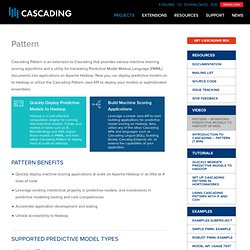
Now you can deploy predictive models on to Hadoop or utilize the Cascading Pattern Java API to deploy your models or sophisticated ensembles. Pattern Benefits Quickly deploy machine scoring applications at scale on Apache Hadoop in as little as 4 lines of codeLeverage existing intellectual property in predictive models, and investments in predictive modeling tooling and core competenciesAccelerate application development and testingUnlock accessibility to Hadoop Hierarchical ClusteringK-Means ClusteringLinear RegressionLogistic RegressionRandom Forest Algorithm Using Maven.
NIPS : NIPS. Machine Learning Repository. Octave Programming Tutorial. From the Octave website: Octave is a high-level language, primarily intended for numerical computations.
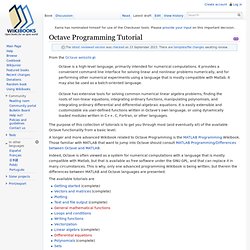
It provides a convenient command line interface for solving linear and nonlinear problems numerically, and for performing other numerical experiments using a language that is mostly compatible with Matlab. It may also be used as a batch-oriented language.Octave has extensive tools for solving common numerical linear algebra problems, finding the roots of non-linear equations, integrating ordinary functions, manipulating polynomials, and integrating ordinary differential and differential-algebraic equations. It is easily extensible and customizable via user-defined functions written in Octave's own language, or using dynamically loaded modules written in C++, C, Fortran, or other languages. The purpose of this collection of tutorials is to get you through most (and eventually all) of the available Octave functionality from a basic level.
The available tutorials are in any order. Machine Learning in R, in a nutshell. CS 229: Machine Learning (Course handouts) Lecture notes 1 (ps) (pdf) Supervised Learning, Discriminative Algorithms Lecture notes 2 (ps) (pdf) Generative Algorithms Lecture notes 3 (ps) (pdf) Support Vector Machines Lecture notes 4 (ps) (pdf) Learning Theory Lecture notes 5 (ps) (pdf) Regularization and Model Selection Lecture notes 6 (ps) (pdf) Online Learning and the Perceptron Algorithm.
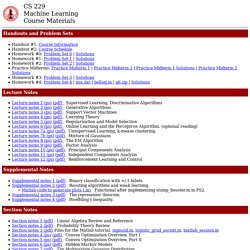
(optional reading) Lecture notes 7a (ps) (pdf) Unsupervised Learning, k-means clustering. Lecture notes 7b (ps) (pdf) Mixture of Gaussians Lecture notes 8 (ps) (pdf) The EM Algorithm Lecture notes 9 (ps) (pdf) Factor Analysis Lecture notes 10 (ps) (pdf) Principal Components Analysis Lecture notes 11 (ps) (pdf) Independent Components Analysis Lecture notes 12 (ps) (pdf) Reinforcement Learning and Control Supplemental notes 1 (pdf) Binary classification with +/-1 labels. Supplemental notes 2 (pdf) Boosting algorithms and weak learning. Lzhang10/maxent. Maximum Entropy Modeling. This page dedicates to a general-purpose machine learning technique called Maximum Entropy Modeling (MaxEnt for short).

On this page you will find: What is Maximum Entropy Modeling In his famous 1957 paper, Ed. T. Jaynes wrote: Information theory provides a constructive criterion for setting up probability distributions on the basis of partial knowledge, and leads to a type of statistical inference which is called the maximum entropy estimate.
Maximum Entropy Modeling has been successfully applied to Computer Vision, Spatial Physics, Natural Language Processing and many other fields. The concept of Maximum Entropy can be traced back along multiple threads to Biblical times. Maximum Entropy was first introduced to NLP area by Berger, et al (1996) and Della Pietra, et al. 1997. MaxEnt 2013 Home. Index of /publiccorpus. Octave. Boltzmann machine. A Boltzmann machine is a network of symmetrically connected, neuron-like units that make stochastic decisions about whether to be on or off.
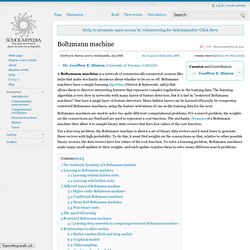
Boltzmann machines have a simple learning algorithm (Hinton & Sejnowski, 1983) that allows them to discover interesting features that represent complex regularities in the training data. The learning algorithm is very slow in networks with many layers of feature detectors, but it is fast in "restricted Boltzmann machines" that have a single layer of feature detectors.
Many hidden layers can be learned efficiently by composing restricted Boltzmann machines, using the feature activations of one as the training data for the next. Boltzmann machines are used to solve two quite different computational problems. For a search problem, the weights on the connections are fixed and are used to represent a cost function.
Adaptive Learning Algorithms for Bayesian Network Classifiers. Autonomous Helicopter: Stanford University AI Lab. Book. Getting In Shape For The Sport Of Data Science. Weka 3 - Data Mining with Open Source Machine Learning Software in Java. Weka is a collection of machine learning algorithms for data mining tasks. It contains tools for data preparation, classification, regression, clustering, association rules mining, and visualization. Found only on the islands of New Zealand, the Weka is a flightless bird with an inquisitive nature. The name is pronounced like this, and the bird sounds like this. Weka is open source software issued under the GNU General Public License.
We have put together several free online courses that teach machine learning and data mining using Weka. Adaptive Learning Algorithms for Bayesian Network Classifiers. Weka 3 - Data Mining with Open Source Machine Learning Software in Java. Octave Tutorial - Numerical Variables. When evaluating the value of an expression, the result is stored in a variable called ans (answer).

You can also introduce variables of your own. By writing who you can see all variables. If you write a semi colon at the end of the line, the output is not shown. Naming variables Various programs have different rules for naming entities. The first character must be an english letter : a -z, A - Z Some programs can handle letters like å, Æ, Ç, ü; others cannot. These rules apply to Octave and a number of other programs.
Assignments When writing a=5 at the command prompt, the equal-sign should not be thought of as a logical equality; a is not equal to 5, it is assigned the value 5. A=a+1 The statement above would be false if it was a logical statement, it is however not a logical statement but an assignment. MacinCloud - Rent a Mac in the Cloud! - Mac in Cloud. Octclipse - Browse /0.10.1. MATLAB Programming. MATLAB is a programming language developed by MathWorks.
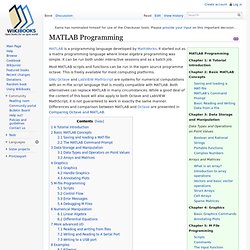
It started out as a matrix programming language where linear algebra programming was simple. It can be run both under interactive sessions and as a batch job. Most MATLAB scripts and functions can be run in the open source programme octave. This is freely available for most computing platforms. MATLAB Programming/Differences between Octave and MATLAB. Octave has been mainly built with MATLAB compatibility in mind.
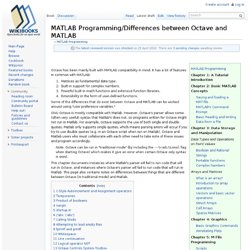
It has a lot of features in common with MATLAB: Matrices as fundamental data type. Built-in support for complex numbers. Online LaTeX and Octave Editor. Yann.lecun.com/exdb/publis/pdf/lecun-98b.pdf. Neural Network for Recognition of Handwritten Digits. Download the Neural Network demo project - 203 Kb (includes a release-build executable that you can run without the need to compile) Download a sample neuron weight file - 2,785 Kb (achieves the 99.26% accuracy mentioned above) Download the MNIST database - 11,594 Kb total for all four files (external link to four files which are all required for this project) Contents Introduction This article chronicles the development of an artificial neural network designed to recognize handwritten digits.
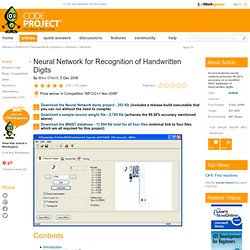
Although some theory of neural networks is given here, it would be better if you already understood some neural network concepts, like neurons, layers, weights, and backpropagation. The neural network described here is not a general-purpose neural network, and it's not some kind of a neural network workbench. The idea of using neural networks for the purpose of recognizing handwritten digits is not a new one. Y. Armadillo: C++ linear algebra library. Octave.